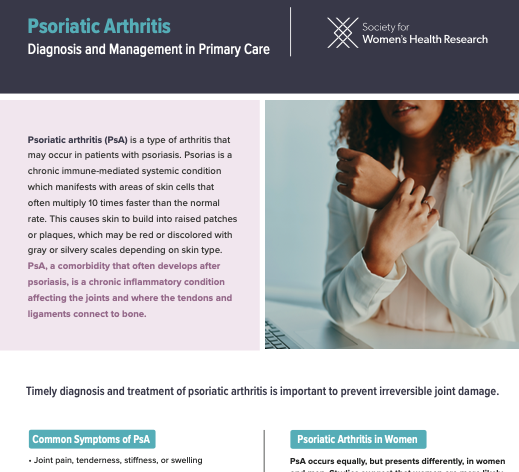Psoriatic arthritis (PsA) is a chronic immune-mediated systemic condition that affects about 30% of people with psoriasis (1). While PsA can start any age, according to the National Psoriasis Foundation, the disease often appears between ages 30 and 50—and it can develop slowly and mildly, or quickly and severely.
Though PsA occurs at a roughly 1:1 ratio between men and women, it presents differently in each, though the biological cause for these differences is unknown. Specifically, studies have suggested that women are more likely to experience polyarthritis (arthritis impacting five or more joints); symptoms in the peripheral joints (arms, hands, feet), whereas men are more likely to experience symptoms in their spine and sacroiliac joints; more patient-reported pain, swollen joint count, fatigue, and functional difficulties; and worse patient-reported responses to treatment and remission.
This month—Psoriasis Awareness month—the Society for Women’s Health Research (SWHR) is launching its new Psoriatic Arthritis: Diagnosis and Management in Primary Care Fact Sheet, designed to help both clinicians and patients in their approach to diagnosing and treating PsA. In a recent roundtable discussion hosted by SWHR, National Psoriasis Foundation Chief Scientific and Medical Officer Dr. Stacie Bell noted the challenge and importance of PsA’s timely diagnosis:
“I can’t tell you the number of patients I have on a weekly basis who have had months-long delay in diagnosis that resulted in worsened disability.”
Through utilization of this fact sheet—which reviews common symptoms and risk factors of PsA as well as information on diagnosing and treating PsA—SWHR hopes that both patients and health care providers will be equipped to swiftly recognize PsA and identify a treatment plan tailored to the individual patient.
Download The PsA: Diagnosis And Management In Primary Care Fact Sheet
This fact sheet is a project of SWHR’s Autoimmune Skin Program, which works to engage and educate patients, health care providers, and policymakers about the burden of autoimmune skin diseases. Thanks to our sponsor, Eli Lilly & Co., for their support of this educational piece.
(1) Mease, P. J., Gladman, D. D., Papp, K. A., Khraishi, M. M., Thaci, D., Behrens, F., … Alvarez, D. (2013). Prevalence of rheumatologist-diagnosed psoriatic arthritis in patients with psoriasis in European/North American dermatology clinics. J Am Acad Dermatol, 69(5), 729-735. doi:10.1016/j.jaad.2013.07.023
